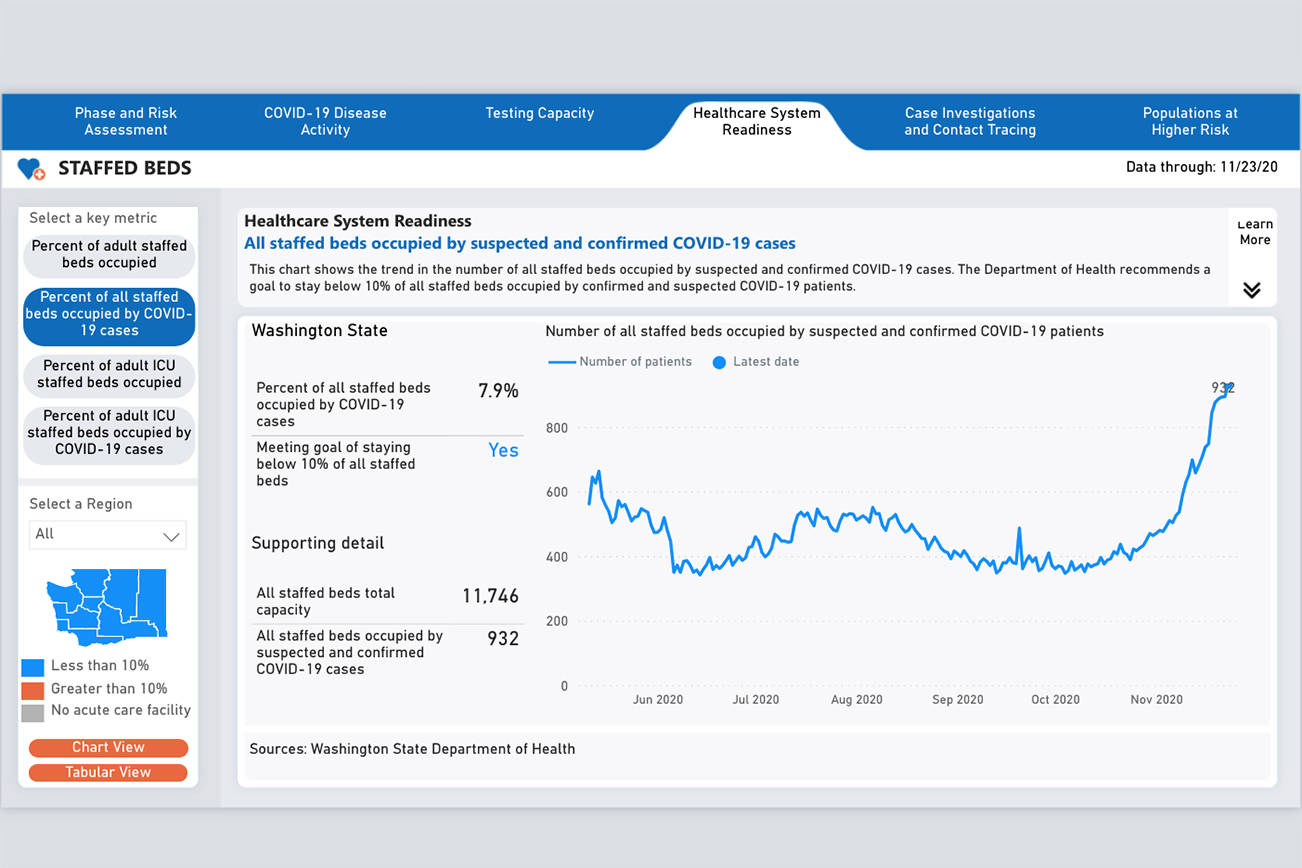Submitted by the Washington State Department of Health
COVID-19 hospital occupancy is rapidly increasing throughout Washington as the state continues to experience exponential growth in new cases. We are seeing alarming increases in the number of COVID-19 patients in our hospitals as well as the number hospitalized in Intensive Care Unit beds — critical capacity needed to treat severe COVID-19 cases as well as other patients with serious conditions.
The trend is highlighted in new data added to the state’s Risk Assessment dashboard today. The dashboard shows that the number of confirmed and suspected COVID-19 patients in our hospitals doubled from 471 on Nov. 1 to 932 on Nov. 23. In addition, the number of confirmed and suspected COVID-19 patients in our ICUs increased by about 75 percent from 124 on Nov. 1 to 214 on Nov. 23. If this doubling rate continues, we may have over 1800 COVID-19 patients in our hospitals by mid-December.
Because COVID-19 patients may stay in the hospital for several weeks, hospital occupancy will continue to rise for some time even after hospital admissions level off. In some cases, large hospital systems are facing situations that would necessitate delaying non-urgent procedures due to a lack of staffed hospital beds. Situations like this can cause other patients with non-COVID-19 conditions to have to wait, and this also impacts anyone who else may need to seek care. It is imperative that we ensure access to hospital care for anyone who needs it, whether they have COVID-19 or another illness or injury.
“This situation is extraordinarily urgent, and we need everyone in Washington state to take action now to stop the spread of COVID-19 before our hospitals and frontline healthcare workers are overwhelmed,” said State Health Officer Dr. Kathy Lofy. “I am extremely concerned about the current exponential growth of COVID-19 cases. We must all re-commit to flatten the curve now.”
The Department of Health worked with healthcare system partners and Microsoft AI for Health to improve the hospitalization data in the risk assessment dashboard. The updated hospitalization data show occupancy of ICU beds, where capacity is likely to be exceeded first. The new data include the number and percent of adult staffed beds occupied by any patients; the number and percent of all staffed beds occupied by COVID-19 patients; the number and percent of adult ICU staffed beds occupied by any patients; and the number and percent of adult ICU staffed beds occupied by COVID-19 patients.
“Accurate and relevant data is critical to allow all of us to work together to ensure no individual hospital or region is overwhelmed with COVID-19 cases,” said Darcy Jaffe, senior vice president of safety and quality for the Washington State Hospital Association.
These new changes better reflect the impact of COVID-19 patients on our hospital system and the capacity of hospitals to care for patients because hospitals need both a bed and staff to care for a patient. Additionally, the dashboard has been updated to reflect data by region, as opposed to counties. This was done because hospitals in the same region are likely to share patient loads.
“As cases have risen again in Washington, it is important to use technology and data analytics so we can have a better understanding of what resources and capacity we have at our hospitals to help those needing care. We are committed and honored to work with local and state officials to understand and stop the spread of COVID-19.” John Kahan, VP, Chief Data Analytics Officer, and global lead for the AI for Health program, Microsoft.
There is still time for Washingtonians to make a difference. Wear a mask around people you don’t live with (even close friends and family). Stay home as much as possible, and don’t gather with people outside your immediate household. Wash your hands frequently, get your flu shot and stay home if you’re sick.



